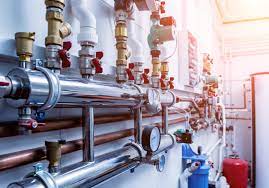Commercial plumbing systems form the backbone of numerous businesses and institutions, providing the essential infrastructure for water supply, drainage, and waste disposal. Unlike residential plumbing, which primarily serves individual households, commercial plumbing caters to larger-scale operations, making it more complex and demanding. This article aims to delve deeper into the intricacies of commercial plumbing, offering valuable insights into its various facets and highlighting the critical considerations businesses should keep in mind.
System Design and Installation:
Commercial plumbing systems are engineered to handle higher volumes of water and more complex layouts than residential setups.
The design and installation process must be meticulous, involving professionals with expertise in commercial plumbing.
This includes considering factors such as water pressure, flow rates, and potential expansion needs.
Adherence to local building codes and regulations is paramount to ensure the safety and functionality of the system.
Water Conservation Strategies:
In an era where environmental consciousness is a priority, businesses must adopt water conservation strategies.
Installing low-flow fixtures, water-efficient appliances, and implementing leak detection systems can significantly reduce water consumption.
Regular maintenance and employee education about responsible water usage further contribute to sustainability efforts.
Regular Maintenance and Inspections:
Preventive maintenance is the cornerstone of a reliable commercial plumbing system. Regular inspections, typically scheduled at least twice a year, help identify potential issues before they escalate.
This proactive approach not only prevents unexpected disruptions but also extends the lifespan of plumbing components, reducing long-term costs.
Code Compliance:
Compliance with local building codes and regulations is non-negotiable in commercial plumbing. Staying abreast of code updates and changes is essential, as failure to comply may result in legal consequences and compromise the safety of occupants.
Engaging with experienced professionals who are well-versed in local codes is crucial for a smooth and compliant installation.
Backflow Prevention:
Backflow, the undesirable reversal of water flow, poses a serious risk of contaminating the public water supply. Businesses must install and regularly maintain backflow prevention devices to safeguard against this potential hazard.
This not only ensures regulatory compliance but also protects the health and well-being of employees and customers.
Emergency Preparedness:
Developing a robust emergency response plan is imperative for commercial establishments. Plumbing emergencies, such as leaks or clogs, can disrupt operations and lead to costly damages if not addressed promptly.
Having a well-defined plan in place ensures quick and effective resolution, minimizing downtime and potential losses.
Sewer Line Maintenance:
Commercial buildings often have extensive sewer systems that handle substantial waste volumes. Regular maintenance, including routine cleaning and inspections, is essential to prevent blockages, leaks, and potential health hazards.
Timely identification and resolution of sewer line issues are critical to avoiding disruptions and maintaining a healthy working environment.
Upgrading to Modern Technology:
Embracing modern plumbing technologies can enhance the efficiency and sustainability of commercial plumbing systems. Smart plumbing solutions, sensor-based fixtures, and automated monitoring tools provide real-time insights, enabling businesses to optimize water usage, detect leaks, and reduce operational costs.
Investing in these innovations positions businesses at the forefront of plumbing efficiency.
FAQs:
Q1: How often should commercial plumbing systems be inspected?
A: Regular inspections, ideally conducted biannually, help identify and address potential issues before they become major problems.
Q2: Can commercial buildings use the same plumbing fixtures as residential properties?
A: While some fixtures may overlap, commercial buildings often require heavy-duty, water-efficient fixtures designed for higher usage and durability.
Q3: What are the consequences of non-compliance with plumbing codes?
A: Non-compliance may result in fines, legal action, and, in severe cases, the shutdown of business operations. Additionally, it poses risks to the safety of occupants and the public.
Q4: How can businesses promote water conservation in commercial plumbing?
A: Implementing water-saving technologies, conducting regular maintenance, and educating employees about water conservation practices are effective strategies.
Q5: What is backflow and why is it a concern in commercial plumbing?
A: Backflow is the unwanted reversal of water flow, posing a risk of contamination. In commercial plumbing, backflow prevention is crucial to protect the public water supply and ensure regulatory compliance.
Conclusion:
In conclusion, navigating the complexities of commercial plumbing requires a comprehensive understanding of various factors, from system design and water conservation to code compliance and emergency preparedness. Businesses that prioritize proactive maintenance, invest in modern technologies, and stay vigilant about regulatory requirements not only ensure the reliability of their plumbing systems but also contribute to a sustainable and safe working environment. As commercial establishments continue to evolve, so too must their approach to plumbing to meet the demands of a dynamic and environmentally conscious world.

A group of home improvement enthusiasts and bathroom design experts, combines in-depth knowledge and a shared passion to deliver engaging, informative content that guides readers through the world of bathroom innovation and style.

Leave a Reply